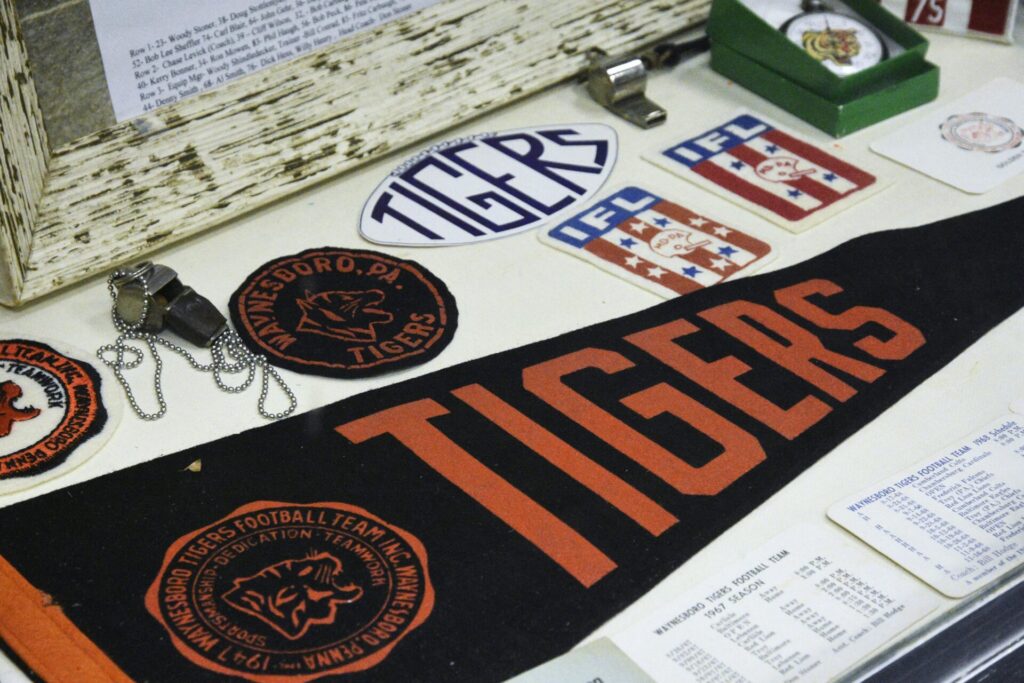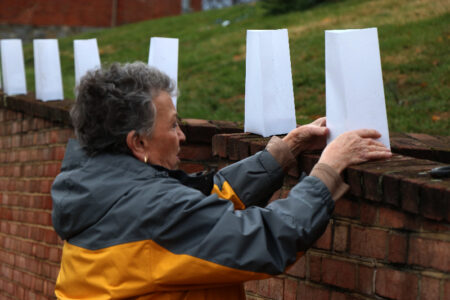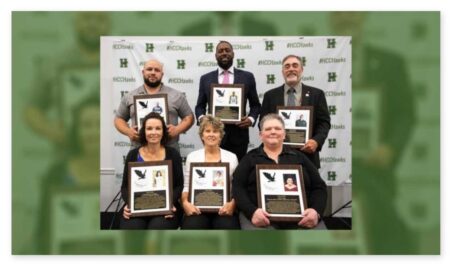At first glance, the history of the Waynesboro Tigers football team fits neatly into a three-act play. The squad burst into prominence during the late 1940s, sporting orange and black uniforms in their opening scene. They dominated opponents and inspired civic pride. During a second act, the Tigers disappeared for a spell, but later reemerged to compete and reclaim their storied identity. Eventually, their good fortune declined due to changing culture and unforeseen events. The Tigers’ tale concluded with a seemingly final chapter, as the team ultimately faded into local lore.
But although this football team disbanded, and gridiron glory days ended nearly a half-century ago, the Waynesboro Tigers’ story is still evolving. The surviving players’ diehard spirit, charitable heritage, and well-preserved memories keep their athletic legacy alive and relevant. After emerging from a sociable huddle, these Tigers are now lined up for a ceremonial fourth down.
As the Tiger’s first act started, loosely organized Waynesboro neighborhood football teams had formed by the 1930’s. The north end fielded the ‘Bombers’, and the ‘Eastenders’ represented that geographic Waynesboro section. In the town’s southern area, the ‘Green Dragons’ were a formidable football team. Sometime before World War II, those dragons commissioned new uniforms. When the jersey’s arrived, they were mistakenly colored black and orange. This glitch didn’t faze the Green Dragons- they simply renamed themselves the Tigers.
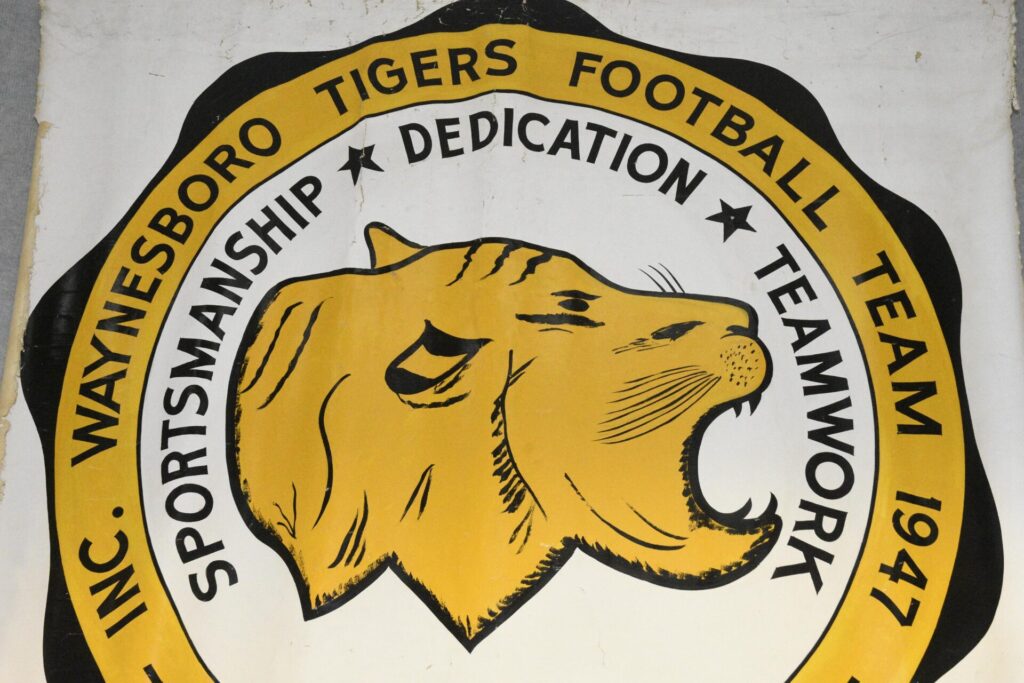
A move to consolidate those local teams began in 1946. The following year, the Waynesboro Tigers incorporated; a mixture of neighborhood football talent. With lights on site at the Fairview Avenue School stadium- one of the first illuminated fields in the Cumberland Valley- the Tigers found a new home venue for night games.
The inaugural Tigers team possessed dual credentials that pushed them toward excellence. Most players were World War II veterans, happy to return safely to their hometown, and filled with pride and energy. Many were also former players tutored by legendary Waynesboro High School football coach ‘Rip’ Engle, who eventually became Penn State’s Head Coach and later mentor to Joe Paterno. Engle taught his Waynesboro players lessons in sportsmanship. They never forgot them.
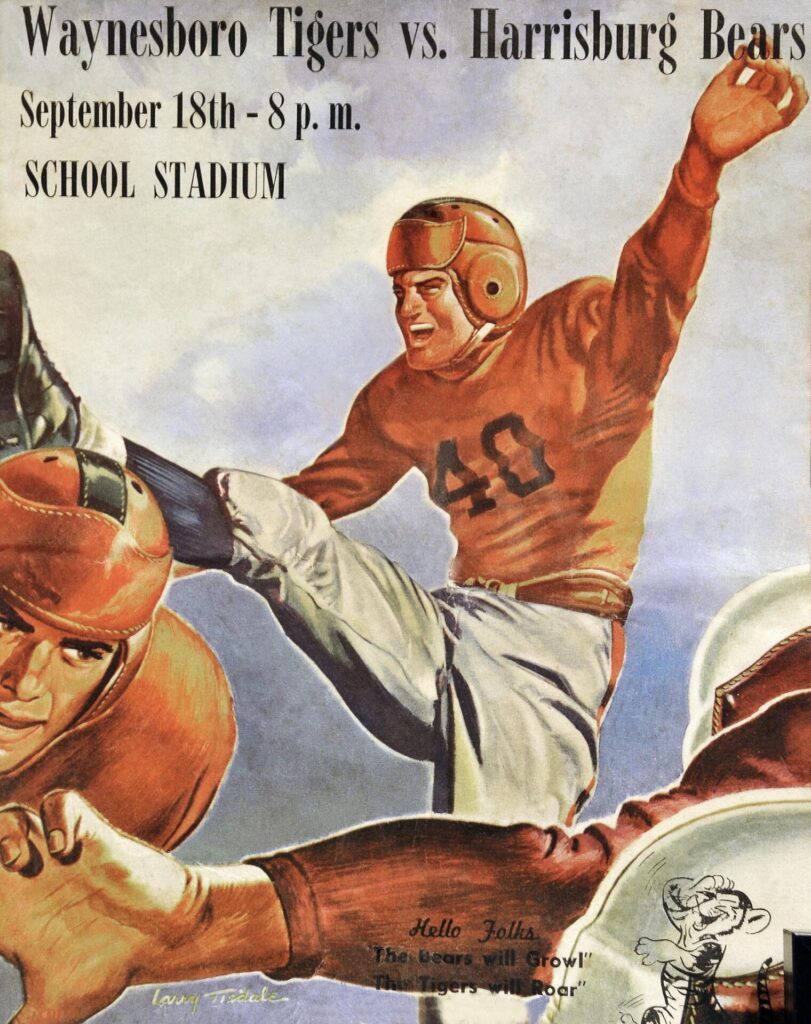
Tiger players were considered ‘Semi Pro’. But they usually received no more than sponsored equipment and gas money for away contests. Game tickets cost 25 cents. The community-minded Tigers took some profits and reinvested them into stadium improvements, including a new electric scoreboard and a press box. They also participated in other local charitable ventures, showing appreciation for Waynesboro’s enthusiastic support.
The Waynesboro Tigers achieved a near perfect season in 1947. Their record of 11-0-1 was only blemished by a 6-6 tie with the Baltimore Marines. In that game, called ‘deadlock in the mud’, Tiger player Buffalo Wetzel recovered a fumble in the closing seconds to preserve a tie. That season, the Tigers outscored opponents 287 to 46. Ten of twelve games were played at home, where Waynesboro fans served as the twelfth man. An estimated 30,000 fans witnessed the Tigers’ fantastic play that year. The next season, the Tigers were flawless, finishing 11-0.
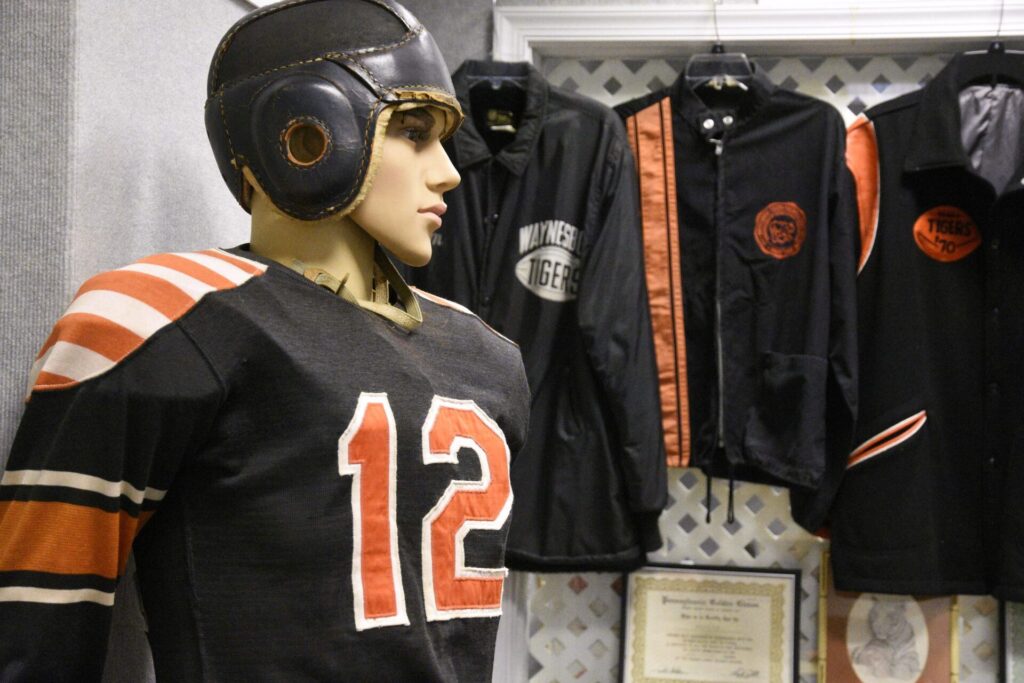
As the Tigers became a Waynesboro sensation, regular home games attracted 4000 fans- nearly half the town’s population. For contests featuring major rivals, attendance swelled to over 8,000. ‘Horky’ Elmes was a middle-aged Frick Company employee and the most glorified Tigers fan. The hometown crowd called this unique character Mister Hi-De-Ho. Fans named him for the boisterous cheer he led. The Wayne Band and Tigers cheerleaders also added to the festive atmosphere at home games. Around town, Tigers players were treated like celebrities.
The Waynesboro Tigers played teams from Hanover, Hagerstown, Westminster, and Harrisburg in the following years. But no rival loomed larger than the Chambersburg Cardinals. The Tigers’ 13-6 win over the Cardinals in 1949 was likely seen by more fans than any athletic event in Franklin County history. Waynesboro and the team celebrated that night. Jubilant Tiger Head Coach Joe Kugler exclaimed: “I’m so proud of these guys!”
The Tigers entered the 1950 season with a 21-game unbeaten streak. Standout players like Ray Dull and ‘Quack’ Geeseman thrilled Waynesborians with their exceptional play. The Tigers spoiled their fans- they expected dominance. This team usually delivered. But the Tigers lost to Chambersburg that year, a major disappointment to players and their fans.
In the 50s, the Tigers squad showed they were mortal. Some experienced injuries or retired with advancing age. Others players departed to devote needed energy to raising a family or earning a living. The team’s perfect chemistry started to dilute.
Also in that era, the Tigers competed with television, which broadcast professional NFL games. Tigers’ home attendance dropped. By 1954, most of the original Tigers were gone and the team opened their season with a drab 0-0 tie. The next year, the Tigers departed the Interstate Football League (IFL). Then, they faded away.
A second act in the Tigers’ story commenced during the 1960s. A new generation of local athletes yearned to resurrect the team’s former glory. This enthusiastic group raised 2000 dollars from local sponsors and the next Tigers’ incarnation began with the motto: ‘Bring ‘Em Back Alive in ‘65’. Despite their war chest, the players used electrical tape to adorn their football helmets with three stripes. The Tigers rejoined the IFL, made up of eight teams in two divisions.
Lanny Carbaugh and Bill Hough played on those 1960s Tigers teams. Both men agree their team played a tough style of football. “We could scrap with anybody,” Carbaugh said. “You give us your best, and we’ll throw it right back at you.” Bill Hough remembers the fierce competitiveness among his teammates. According to Bill, one Tigers’ lineman was so bad-tempered he’d bite opponents while entangled in pileups. Hough also recalled the camaraderie that developed with his surviving fellow Tigers as they competed and traveled to away games. “Those guys are still my friends today.”

That inaugural second-generation Tigers season produced a 6-4 record, and the next four years saw the team win more games than they lost. But in the 70s, that winning trend reversed. Required to play half their games on the road, this diminished the Tigers’ secret weapon: their hometown fans. As ticket sales dropped, the team needed funds to keep playing. They held raffles and even sold Christmas trees. In 1972, the Tigers sold a commemorative 25th Anniversary Plate that artfully pictured the original 1947 team. “We struggled to stay alive,” Carbaugh said, “But we kept going.”
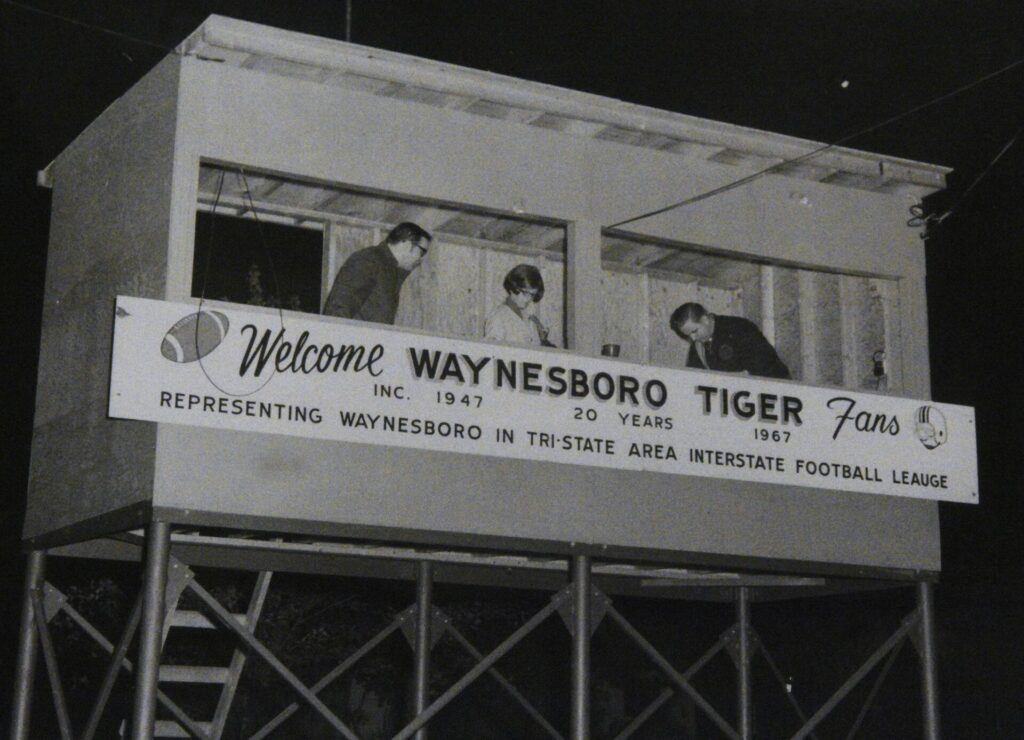
Despite their devotion on and off the field, the Tigers’ fortunes declined. Local loyalty was siphoned in 1974 when the High School Indians enjoyed a landmark undefeated season. In addition, many Tigers were no longer Waynesboro citizens, and fans had greater affection for players they knew as neighbors.
In a local tragedy that same year, the Fairview Avenue School burned down, and the Tigers lost their home stadium. The next season, the Chambersburg Cardinals folded, and when the biggest rival on the Tigers’ schedule vanished, local fan interest dwindled further.
The Tigers played their last game in 1977. Despite never reclaiming the magic of those original 1940/50s teams, this second Tigers group played spirited football and are justly proud of their legacy. This second generation lasted longer than the first.
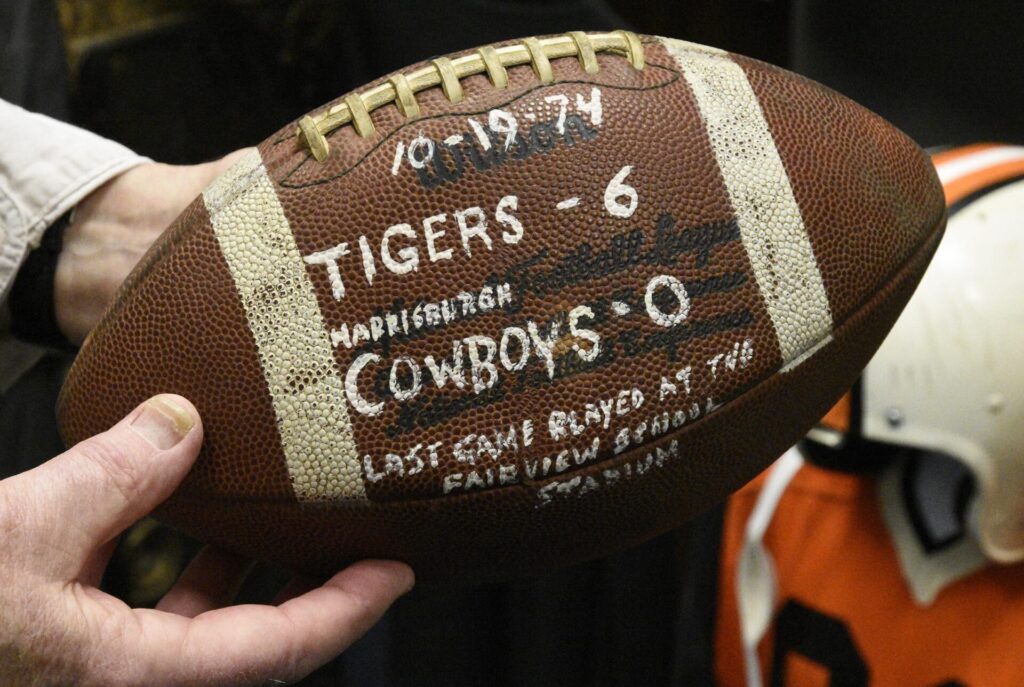
Special fellowship kept these Tigers in contact with each other. Many years later, another era began as former players gathered for lunch at the Parlor House. These men eventually developed a Tigers alumni group in 2008. In 2015, they celebrated the 50th Anniversary of the 1965 team.
Lanny Carbaugh, the former player and Head Coach (and now team Secretary), began wearing a new helmet- as unofficial curator of Tigers’ history. Artifacts were donated and gathered from past players and fans. A team memorabilia room grew with these old pictures, uniforms, footballs, and other treasures from past Tigers’ seasons. Audio tapes from vintage radio broadcasts were also discovered, to relive those glory years.
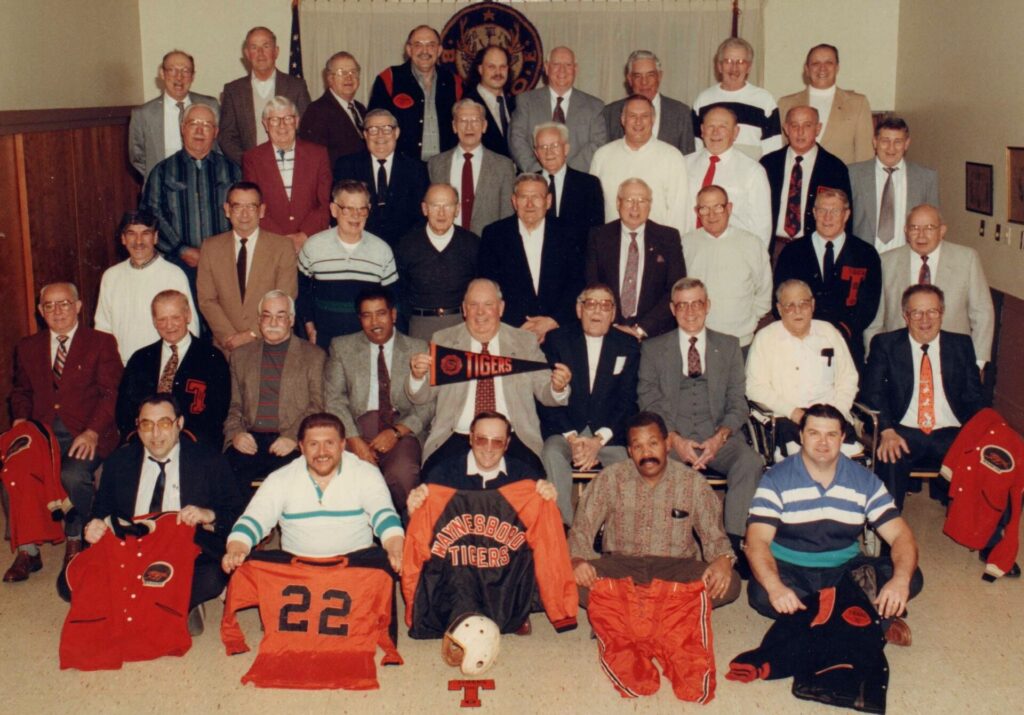
In 2011, the Waynesboro Tigers revisited their charitable past and established a scholarship program. The team awards a $1000 grant each year to a local football player headed to college. With this generous gift, the Tigers not only honor their former football lives, but encourage future Waynesboro stars to pursue a higher education through the sport they love.
The untiring enthusiasm for the Tigers’ legacy is well represented by Lanny Carbaugh. Now 86, with a trim physique and the spry persona of a former athlete, he could easily pass for a man fifteen years younger. Current Tigers Alumni President Bill Hough gives much credit to Carbaugh’s influence on the Tigers’ still-evolving legacy. “Lanny’s done so much for this team.”

In Waynesboro’s past, few groups achieved the status and admiration given to the Tigers. This team of talented men, who played hard-nosed football in four different decades, personified an ideal beyond athletics. The Waynesboro Tigers were a source of community pride and cultural identity. Their athletic feats are a cherished chapter in local history. The river of affection between the town and team flowed in both directions. For surviving Tigers players and their reminiscent fans, that shared admiration and respect endures.
